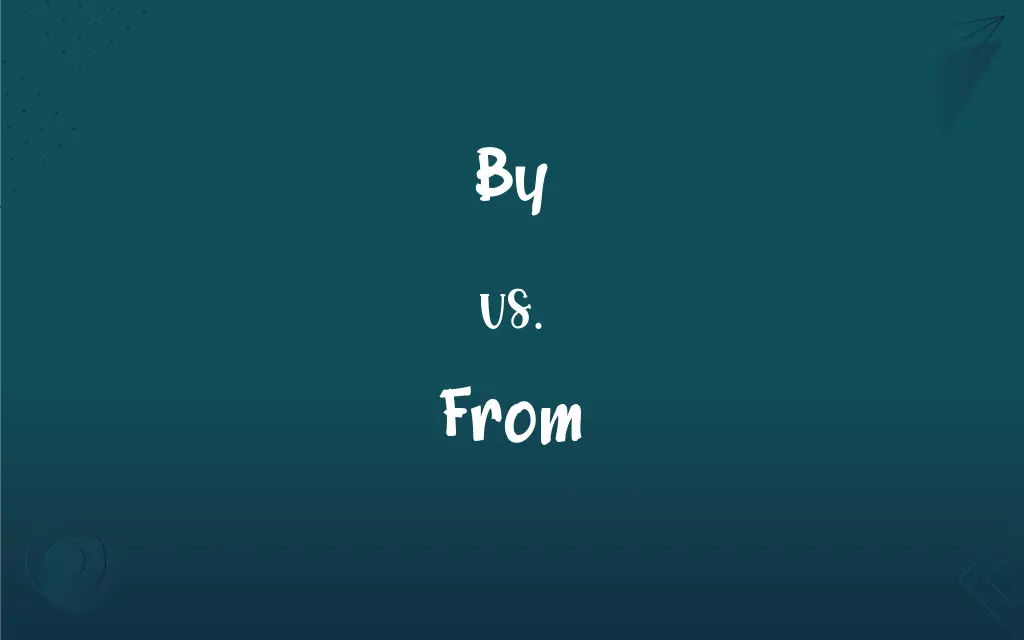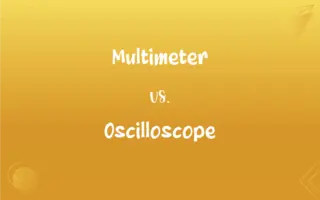By vs. From: What's the Difference?
Edited by Aimie Carlson || By Janet White || Published on November 30, 2023
"By" often indicates the agent performing an action or a method used, while "from" denotes origin, source, or separation.

Key Differences
"By" is commonly used to identify the agent or cause of an action, as in "The cake was baked by Jane." It emphasizes the doer of an action. On the other hand, "from" is used to indicate the source, origin, or starting point, as in "She received a gift from her friend." It focuses on where something starts or comes from.
In terms of method or means, "by" suggests the way something is done, like in "He travels by train." It highlights the process or means. Conversely, "from" can signify the point of departure or change, as in "The temperature dropped from 20 to 10 degrees." It indicates a starting point in a range or sequence.
"By" also sets a deadline, implying a time before which something happens, as in "Finish your work by 5 PM." It sets a temporal boundary. Contrastingly, "from" can be used to show duration, starting at a point in time, such as in "The shop is open from 9 AM to 5 PM," indicating the beginning of a time period.
Spatially, "by" can denote proximity, suggesting nearness or alongside, as in "The house by the lake." It implies closeness. In contrast, "from" can express a point of origin in terms of space, like in "He walked from the store to his home," indicating movement away from a place.
"By" is also used in passive constructions to identify the agent, as in "The novel was written by her." It links actions to their performers. "From" is used to express differentiation or contrast, as in "Different from her opinion," highlighting a point of difference.
ADVERTISEMENT
Comparison Chart
Agent of Action
Indicates who performs an action
Denotes the source or origin of something
Method or Means
Describes how something is done
Shows the starting point or origin
Temporal Usage
Sets a deadline or time limit
Indicates the beginning of a time period
Spatial Relation
Implies proximity or nearness
Expresses movement away or origin in space
Usage in Sentences
Often used in passive voice
Used to show contrast or differentiation
ADVERTISEMENT
By and From Definitions
By
Indicating who performs an action.
The painting was completed by a famous artist.
From
Denoting a point of departure or differentiation.
She walked away from the crowd.
By
Describing the method used.
She travels by bus.
From
Showing a transition or transformation.
He changed from happy to sad quickly.
By
Setting a deadline for an action.
The report must be submitted by Monday.
From
Indicating what something is made of.
The table is made from wood.
By
Denoting nearness to a place or object.
The cafe is right by the museum.
From
Indicating the starting point or source.
He comes from Canada.
By
Used in passive sentences to indicate the doer.
The song was written by him.
From
Marking the beginning of a duration.
The store is open from 9 AM.
By
Close to; next to
The window by the door.
From
Used to indicate a specified place or time as a starting point
Walked home from the station.
From six o'clock on. See Usage Notes at escape, whence.
By
With the use or help of; through
We came by the back road.
From
Used to indicate a specified point as the first of two limits
From grades four to six.
From
Used to indicate a source, cause, agent, or instrument
A note from the teacher.
Taking a book from the shelf.
FAQs
What does "by" indicate in a sentence?
"By" often indicates the agent performing an action or a method used.
Can "by" be used to set deadlines?
Yes, "by" is used to indicate a time before which something should occur.
What does "from" express in terms of time?
"From" marks the beginning of a time period.
Is "by" used in passive voice constructions?
Yes, "by" is common in passive voice to identify the agent.
How is "by" used to show proximity?
"By" indicates closeness to a location or object.
Can "by" imply authorization or approval?
Yes, in contexts like "approved by the board."
How is "from" used to denote origin?
"From" is used to specify the starting point or source of something.
How does "from" work in historical contexts?
"From" can indicate the start of a historical period.
Is "by" used to specify frequency?
No, "by" typically doesn't denote frequency.
How does "from" function in geographical references?
It specifies the starting location in a journey.
Can "by" be used in mathematical expressions?
Yes, like "divided by" in division.
Can "by" denote means of transportation?
Yes, "by" can describe how someone travels, like "by car."
What role does "from" play in showing contrast?
"From" is used to highlight differences, as in "different from."
What does "from" mean in culinary terms?
"From" can denote the origin of ingredients.
What does "from" mean in technological contexts?
It can refer to the source of data or information.
How does "from" indicate spatial relationships?
"From" is used to express movement away from a place.
Can "from" describe material composition?
Yes, "from" can specify what something is made of.
Can "from" be used in expressions of emotion?
Yes, like "from happiness to sadness."
Does "by" have a role in musical contexts?
Yes, indicating the creator of music or lyrics.
How does "by" function in legal texts?
"By" can imply conformity to laws or regulations.
About Author
Written by
Janet WhiteJanet White has been an esteemed writer and blogger for Difference Wiki. Holding a Master's degree in Science and Medical Journalism from the prestigious Boston University, she has consistently demonstrated her expertise and passion for her field. When she's not immersed in her work, Janet relishes her time exercising, delving into a good book, and cherishing moments with friends and family.
Edited by
Aimie CarlsonAimie Carlson, holding a master's degree in English literature, is a fervent English language enthusiast. She lends her writing talents to Difference Wiki, a prominent website that specializes in comparisons, offering readers insightful analyses that both captivate and inform.






































































